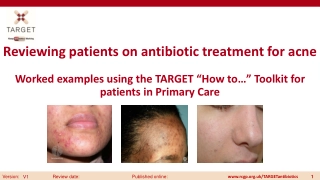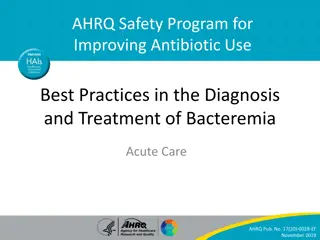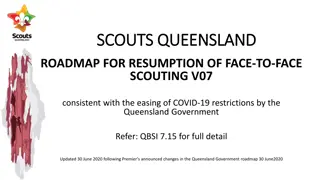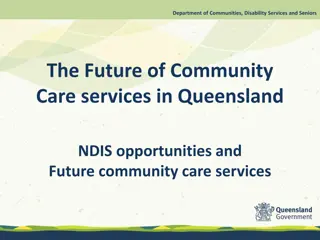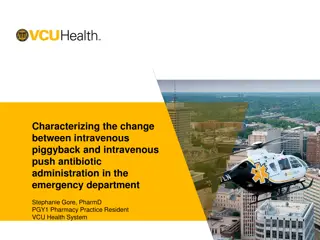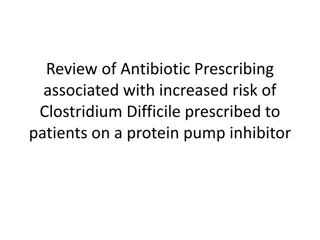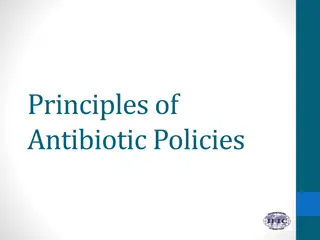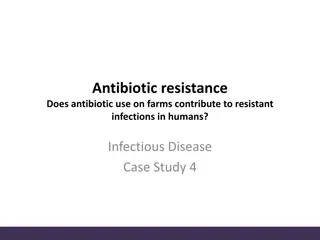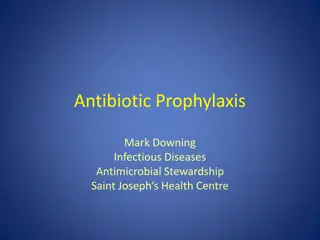Antibiotic Prophylaxis Compliance in Rural Queensland Hospitals
Antibiotic prophylaxis is crucial in surgeries to prevent infections. This study aims to determine compliance with prophylactic antibiotic use in surgeries conducted at Gympie, Dalby, and Kingaroy general hospitals in Southeast Queensland. The primary objective is to compare adherence to guidelines for antibiotic use in different types of surgeries at each site, with secondary objectives including identifying types of surgeries requiring antibiotic prophylaxis and trends in antibiotic use. Data was collected from January 2020 to April 2021 from anaesthetic reports. The study cohort included patients meeting specific criteria across the three hospital sites.
Download Presentation

Please find below an Image/Link to download the presentation.
The content on the website is provided AS IS for your information and personal use only. It may not be sold, licensed, or shared on other websites without obtaining consent from the author. Download presentation by click this link. If you encounter any issues during the download, it is possible that the publisher has removed the file from their server.
E N D
Presentation Transcript
Antibiotic prophylaxis use in surgery performed in South East Queensland rural hospitals Dr Sachith Nanayakkara, Ben Thurgood, Ben Marsden, Cameron Mills
Background Prophylactic use of antibiotics is an essential component in most surgeries to prevent surgical site infections and complications. Patients with SSI remain in hospital an average of 20.3 days longer compared to those without an infection (ACSQHC, 2018). This increased length of stay cumulatively totals $42,102 in extra costs for the Government per patient (ACSQHC, 2018) Australian Commission on Safety and Quality in Health Care (ACSQHC) 3% of surgeries result in SSI Multiple audits across Australian hospitals have shown varying degrees of adherence to SAP, with the lowest adherence rates at 16.5% (Bull et al., 2006, Knox et al., 2016, Friedman et al., 2013) Low compliance to therapeutic guidelines is often observed in Australia. In rural locations, particularly in Queensland, there is a limited amounts of data available to identify compliance and gaps in using antibiotic prophylaxis during surgeries.
Aim Determine compliance in using antibiotic prophylaxis during surgeries performed in Gympie, Dalby and Kingaroy general hospitals between 1stJanuary 2020 and 30thApril 2021
Objectives Primary Objective: 1. Compare adherence of prophylactic antibiotic use in each type of surgery at each site against therapeutic guidelines. Secondary Objectives: 2. Identify types of surgeries performed at Gympie, Dalby and Kingaroy general hospitals that require prophylactic use of antibiotic for surgery 3. Identify trends in type, amount, length of antibiotic use in each surgery at each hospital site
Study Cohort Patients were collected from 3 hospital sites (Gympie, Kingaroy, and Dalby General Hospitals) between 01/01/2020 and 30/04/2021 based on the following exclusion criteria Exclusion Criteria Emergency surgery Patients have been treated with pre-operative antibiotics Patients < 18 years No ENT and Dental surgeries considered Skin procedures except those involving skin grafts Scope Procedures Incomplete anaesthetic reports Total Participants at each site (n) Gympie (n = 484, random selection of 200) Dalby (n = 132) Kingaroy (n = 178)
Methodology Data source: Variables: Data was collected from Anaesthetic reports generated from the Anaesthetic Record Keeping (ARK) software from a combination of: Medical Record Charts The Viewer Demographics Admission details Medical Hx Surgery Time/Agent/Dose of antibiotic administration Time of incision & wound closure Return within 1/52 due to Surgical Site Infection (SSI)
Based on the exclusion criteria 132 surgeries met the inclusion criteria, of which 85 received prophylactic antibiotics Of the surgeries (n=85) that were performed at Dalby Antibiotic administration occurred before surgery in 62 instances General surgery 31/44 Gynaecological surgery 15/24 Obstetric surgery 17/17 Dalby Hospital Surgeries Meeting Inclusion Criteria Distribution of Antibiotic Prophylaxis 60 Other Caesarian Hysteroscopy 50 Lletz Lap. Gynaecological 40 Hysterectomy n = No. Patients Skin Excision Haemorrhoidectomy 30 Open Hernia Lap. Hernia 20 Lap. Cholesystectomy 0 2 4 6 8 10 Cephazolin 2g + Metronidazole 500mg 12 14 16 18 20 Cephazolin 2g 10 Metronidazole 500mg Cephazolin 1g No Prophylactic Antibiotics 0 General Surgry Gynaecological Surgery Obstetric Surgery
Inclusion at Gympie Hospital: Based on exclusion criteria there were 484 eligible surgeries Gympie Hospital A random sample was taken to provide n=200 elective surgical patients. Data collected between 1st January 2020 and 31st April 2021 Collected from Anaesthesia Record Keeping (ARK) software Distribution of Antibiotic Prophylaxis Surgeries Meeting Inclusion Criteria 120 Cesearean Section LLETZ 100 Endometrial Ablation Cone Biopsy 80 Lap Gyn Procedure n = No. Patients Breast Procedure Open Hernia 60 Lap Cholecystectomy Lap Hernia Repair 40 0 10 20 30 40 50 60 20 Cefazolin 2g 0 OTHER - In Line with Therapeutic Guidelines General Surgery Obstetric Surgery Gynaecological Surgery No Prophylaxsis Surgical Categorisation
Inclusion at Kingaroy Hospital: Kingaroy Hospital n = 178 elective procedures Data collected between 1st January 2020 and 31st April 2021 Collected from Anaesthesia Record Keeping (ARK) software Distribution of Antibiotic Prophylaxis Other Hysterectomy Gyn. Lap. Procedure Elective Caesarean Section Skin Lesion excision w/ Graft or Flap Haemorrhoidectomy Open Hernia Open Cholecystectomy Lap. Cholecystectomy Lap. Hernia Repair 0 5 10 15 20 25 30 35 Cephazolin 2g Cephazolin 1g 2 x Cephazolin 1g Cephazolin 2g + Metronidazole 500mg Metronidazole 500mg Lincomycin 600mg Cephalothin 2g IV No Prophylactic Antibiotic
Surgical Antibiotic Prophylaxis Guidelines eTG RANZCOG Surgery Cefazolin 2 g within 60 minutes before Laparoscopic General Surgery Cefazolin 2 g within 60 minutes before Open Hernia Repair Cefazolin 2 g + Metronidazole 500 mg within 60 minutes before within 120 minutes before Cefazolin 2 g + Metronidazole 500 mg within 60 minutes before within 120 minutes before Anorectal Clindamycin 600 mg within 120 minutes before Breast Cefazolin 2 g within 60 minutes before Metronidazole 500 mg + Cefazolin 2 g within 120 minutes before within 60 minutes before Clindamycin 600 mg + Cefazolin 2 g within 120 minutes before within 60 minutes before Gynaecological Cefazolin 2 g within 60 minutes before Caesarean Cefazolin 2 g within 60 minutes before Skin No set recommendation
Trends of antibiotic use across all sites Timing of Antibiotic Administration before Surgical Incision 60 Min. Prior to first incision Timing of Antibitotic Administration (0 = first incision) Time of Surgical Incision
Prophylaxis adherence based on surgery performed Prophylaxis based on surgery performed at each site 100 90 80 % Adherence to Prophylactic Guidelines 70 60 50 40 30 20 10 0 Average Lap Choly Lap Hernia Open Hernia Anorectal Lap Gyn. Hysterectomy Caesarian Skin Graft Dalby Kingaroy Gympie
Appropriate use of antibiotics As previously described appropriate use was determined by: 1. Antibiotic Type 2. Antibiotic Dose 3. Time of Administration (i.e. before first incision and within 60 minutes) Average Antibiotic Adherence based on the above factors Kingaroy = 74% Gympie = 75% Dalby = 52% Factors that may impact Surgical Site Infection: Douglas et al., (2011) Need at least 30 mins prior to incision to have Minimum Inhibitory Concentration 90% (MIC90) Fatty tissue 4 g /g to Staphylococcus aureus resistance breakpoint (Cinotti et al., 2018) Low anticipatory dose of bacteria (~104CFU/mL) - 2g cephazolin is adequate (Heffernan et al., 2021)
Surgical Site Infections Kingaroy was the only site with SSI. 12 (6%) SSI were reported Majority belonged in the general surgery category 7/12 (58%) of procedures resulting in SSI were not adherent to the antibiotic guidelines. SSI at Kingaroy Hospital Skin lesion w/ Flap or Graft Open Cholecystectomy Lap. Cholecystectomy Haemorrhoidectomy Lap. Hernia 0 1 2 3 4 Number of Patients Inappropriate AB Prophylaxis Total SSI
Limitations 1. Audit analysis is still ongoing, however based on raw data it seems likely that the majority of cases with poor adherence are related to inappropriate timing of antibiotic administration. 2. Data collated was limited to Anaesthetic Record Keeping (ARK) software. Timing of antibiotic administration and surgical starting time is therefore dictated by the anaesthetist, leading to potentially inconsistent record keeping, which also impacts limitation 1. 3. Inclusion of skin incisions as a surgical subset was done as it accounts for a significant portion of rural procedures. However, given the lack of guidelines for prophylactic antibiotics in skin based procedures, adherence was calculated purely on timing in those that received antibiotics, which may falsely bring down adherence rates.
Recommendations 1. Review of process for recording timing of antibiotic administration We would recommend a review into the process used for the recording of antibiotic administration time, as we realise that there are discrepancies between what is recorded and the actual time of administration. 2. Appropriate therapeutic guidelines to be generated for skin procedures. 3. Appropriate and consistent reporting is necessary to fully understand which areas require improvement quality improvement
Vote of thanks to RMEA Dr Janani Pinidiyapathirage, Dr Brendan Carrigan & Prof Kay Brumpton Special thanks to Cameron Mills for generosity of his time and help.
References Australian Commission on Safety and Quality in Health Care. (2018, March). Hospital-Acquired Complication: Healthcare Associated Infections. https://www.safetyandquality.gov.au/publications-and-resources/resource-library/hospital-acquired-complication-3-healthcare-associated-infection-fact- sheet Bull A.L., Russo P.L., Friedman N.D., Bennett N.J., Boardman C.J., Richards M.J. (2006). Compliance with surgical antibiotic prophylaxis reporting from a statewide surveillance programme in Victoria, Australia.Journal of Hospital Infection, 63, 140-147. Cinotti, R., Dumont, R., Ronchi, L., Roquilly, A., Atthar, V., Gr goire, M., Planche, L., Letessier, E., Dailly, E., Asehnoune K. (2018). Cefazolin tissue concentrations with a prophylactic dose administered before sleeve gastrectomy in obese patients: a single centre study in 116 patients. British Journal of Anaesthesia, 120(6), 1202-1208. Douglas A., Udy A.A., Wallis S.C. (2011). Plasma and tissue pharmacokinetics of cefazolin in patients undergoing elective and semielective abdominal aortic aneurysm open repair surgery. Antimicrobial Agents Chemotherapy, 55(11), 5238-5242. Friedman D.N., Styles K., Gray A.M., Low J., Athan E. (2013). Compliance with surgical antibiotic prophylaxis at an Australian teaching hospital. American Journal of Infection Control, 41, 71-74. Heffernan A., Alawie J., Wallis S.C. (2021). Pharmacodynamic Evaluation of a Single Dose versus a 24-Hour Course of Multiple Doses of Cefazolin for Surgical Prophylaxis. Antibiotics (Basel), 10(5), 602. Knox M.C., Edye M. (2016). Adherence to Surgical Antibiotic Prophylaxis Guidelines in New South Wales, Australia: Identifying Deficiencies and Regression Analysis of Contributing Factors.Surgical Infections, 17 (2), 203-209.






